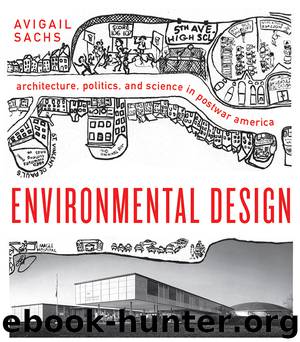Environmental Design: Architecture, Politics, and Science in Postwar America by Avigail Sachs

Author:Avigail Sachs [Sachs, Avigail]
Language: eng
Format: epub
ISBN: 9780813941271
Google: _UuitAEACAAJ
Amazon: 081394127X
Publisher: University of Virginia Press
Published: 2018-01-15T00:43:49.543000+00:00
Figure 33. A diagram accompanying a report on the work of the Sub Committee on National Design Strategy, which was part of the Urban Design Committee of the American Institute of Architects. The diagram illustrates the “ecological” approach to design that was popular in the late 1960s. (AIA Journal, October 1969, Courtesy of the Archives of the American Institute of Architects)
The interest in ecology was registered in an expansion of architecture education, to include “environmental studies.” Also at Berkeley, Donald Appleyard, working with his colleagues’ support, obtained an “environmental simulator,” which allowed the researcher to “drive” through new designs, thus extending the reach of programming (fig. 34). At the University of Pennsylvania, the Institute for Environmental Studies was established in 1965, replacing two predecessor institutes: The Institute for Urban Studies (established in 1951), which was the research arm of the Department of City and Regional Planning; and the Institute for Architectural Research (established in 1959), which was affiliated with the Department of Architecture. In 1965–66, the new institute proposed a Program of Continuing Education for Senior Fellows in Environmental Design Studies. Its purpose was to recognize “the de facto role of architects in large-scale developmental planning and design.”26 In Cambridge, Massachusetts, MIT inaugurated the Laboratory for Environmental Studies, with financial support from the MIT Urban Systems Laboratory, the Harvard-MIT Joint Center for Urban Studies, and foundations and federal agencies such as the Economic Administration and HUD. The lab’s activities, reflecting the changes of the 1960s, were grouped into four areas: race and poverty; psychological perception studies; developing countries; and information systems for urban analysis. 27
Download
This site does not store any files on its server. We only index and link to content provided by other sites. Please contact the content providers to delete copyright contents if any and email us, we'll remove relevant links or contents immediately.
Kathy Andrews Collection by Kathy Andrews(11728)
The remains of the day by Kazuo Ishiguro(8819)
Paper Towns by Green John(5088)
Spare by Prince Harry The Duke of Sussex(5072)
Industrial Automation from Scratch: A hands-on guide to using sensors, actuators, PLCs, HMIs, and SCADA to automate industrial processes by Olushola Akande(4975)
The Body: A Guide for Occupants by Bill Bryson(4974)
Machine Learning at Scale with H2O by Gregory Keys | David Whiting(4175)
Be in a Treehouse by Pete Nelson(3942)
Never by Ken Follett(3788)
Harry Potter and the Goblet Of Fire by J.K. Rowling(3773)
Goodbye Paradise(3726)
Into Thin Air by Jon Krakauer(3308)
The Remains of the Day by Kazuo Ishiguro(3293)
The Cellar by Natasha Preston(3260)
The Genius of Japanese Carpentry by Azby Brown(3224)
Fairy Tale by Stephen King(3218)
120 Days of Sodom by Marquis de Sade(3178)
Drawing Shortcuts: Developing Quick Drawing Skills Using Today's Technology by Leggitt Jim(2996)
The Man Who Died Twice by Richard Osman(2995)
